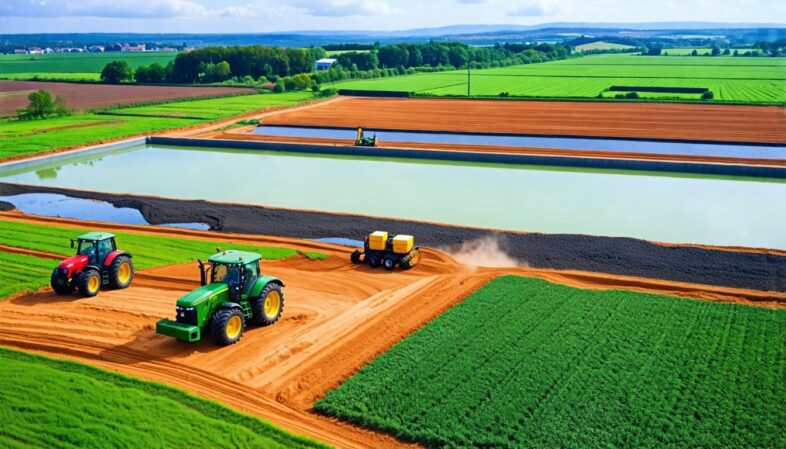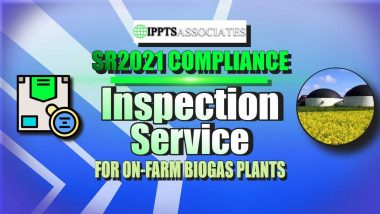In the world of sustainable agriculture, managing waste effectively is a key challenge. Many biogas plant owners are on the lookout for dependable solutions to handle the by-product of anaerobic digestion—digestate.
One pressing issue is finding ways to store this material safely and in compliance with environmental regulations. A standout solution involves constructing SSAFO compliant digestate storage lagoons, designed not only for efficiency but also to meet strict regulatory standards.
One important fact to consider is that the SSAFO Regulations mandate a minimum of four months slurry storage capacity, which directly impacts how digestate storage solutions should be planned and constructed.
This blog aims to guide you through the process of setting up your own compliant digestate storage lagoon, touching upon essential considerations such as utilising farming contractors, integrating AWSM Farming Solutions, and adhering to environmental guidelines.
By ensuring compliance with SSAFO regulations, you can achieve more efficient waste management while contributing positively towards water pollution control and nutrient management.
Prepare for valuable insights into creating an effective system for your agricultural needs – read on!
Key Takeaways
- SSAFO regulations require digestate storage lagoons to have at least four months of slurry storage capacity. This helps in efficient waste management and prevents environmental pollution.
- Farm contractors can quickly build SSAFO compliant digestate storage lagoons, but before they can be built an SSAFO compliance report must be provided and approved by the regulator. At IPPTS Associates consultant Stave Last can often be available for a site inspection within 48 hours. IPPTS Associates offer expertise in constructing these lagoons while ensuring they meet all necessary regulations.
- Properly constructed digestate storage lagoons reduce the risk of release of liquid digestate that could harm the environment. They play a key role in sustainable agriculture by allowing for the spreading of fertiliser only when needed for crop uptake, during the growing season. minimising nutrient runoff into watercourses and reducing odours compared to the land spreading of manure.
- Adhering to SSAFO compliance not only protects the environment but also boosts productivity for biogas plant owners.
- Environmental considerations are crucial when constructing these lagoons. Taking steps to minimise their impact supports sustainable farming operations and contributes towards better resource management in agriculture.
Fill in the form to the right with your details to receive further information on the SSAFO (England) compliance reporting service offered here, on this website.
What is SSAFO Compliance?
What is SSAFO Compliance? In full this refers to compliance with The Water Resources (Control of Pollution) (Silage, Slurry and Agricultural Fuel Oil) (England) Regulations 2010. An expert engineer’s report must be submitted to show that each proposed lagoon complies with the minimum requirements for environmental protection from leakage of the digestate which is a very highly polluting liquid if it escapes.
Compliance with SSAFO regulations ensures environmentally sustainable storage of agricultural fuel oil and slurry. The liquid digestate created after anaerobic digestion is classed as a “slurry” for the purpose of these regulations.
It involves meeting specific requirements for the lining and embankment stability to minimise the risk of an environmental impact due to digestate leakage.

Requirements for Digestate Storage Lagoons
Creating SSAFO compliant digestate storage lagoons is essential for biogas plant owners and designers. These structures must meet specific criteria to ensure environmental safety and regulatory compliance.
- Lagoons must have a minimum of four months slurry storage capacity, as required by the SSAFO Regulations.
- Slurry stores constructed after 1991 should comply with these regulations.
- A clear understanding of river basin management helps in designing lagoons that prevent nutrient runoff into nearby waterways.
- Farm contractors can build digestate storage tanks but must only start once the biogas plant permit holder has submitted and received acceptance of a SSAFO compliance report specific to the lagoon. Planning permission may also be required and must account for the large area needed for lagoon construction.
- Compliance with good practice design rules is crucial to avoid penalties and ensure that manure storage practices do not harm the environment.
- Odour and emissions control systems are not a requirement of the SSAFO regulations, but may be required by the planning authority to minimise the impact of digestate storage on local air quality.
- Earth bank slurry stores require careful design to meet SSAFO requirements, particularly regarding their integrity and leakage prevention measures.
- Agricultural fuel oil storage within the farm should be managed separately from digestate lagoons to prevent contamination.
- Silage storage strategies, and farm fuel oil storage, must also comply with SSAFO regulations to ensure that effluent does not pollute soil or water resources.
- Tighter slurry regulations are anticipated by many for the future, so it’s wise for farmers to prepare by adopting best practices in digestate management now.
With these requirements met, biogas plant owners can achieve efficient digestate storage while ensuring they follow agricultural best practices and contribute positively to environmental sustainability efforts.
Importance of Compliance
By adhering to these standards, farmers can mitigate the impact on surrounding ecosystems and reduce the risk of odour disturbances through effective waste management strategies.
Proper adherence to SSAFO regulations not only safeguards the environment but is also important to preserve the reputation of the anaerobic digestion and biogas industry. Meeting compliance standards fosters efficient waste storage practices, ultimately supporting better yields and maximising efficiency in slurry management.
Additionally, preparing for tighter slurry regulations underscores the significance of upholding strict compliance measures to avoid penalties, or disruptions, for farm activities due to Environment Agency corrective action requirements.
Fill in the form to the right with your details to receive further information on the SSAFO (England) compliance reporting service offered here, on this website.
Constructing a SSAFO Compliant Digestate Storage Lagoon
Construct SSAFO compliant digestate storage lagoons by utilising farming contractors and IPPTS Associates SSAFO compliant design skills. Consider environmental impact during construction.

Utilising Farming Contractors
Earth bank slurry stores have specific storage requirements outlined by the SSAFO Regulations. Biogas plant owners and designers must seek more than just compliance but also efficiency in utilising farming contractors for building these lagoons.
Farm contractors will construct SSAFO compliant digestate storage lagoons, but may not hold the experience in-house to write their own SSAFO compliance reports. The process of approval once the permit holder has submitted a SSAFO compliant report typically takes about 48 hours, efficiently meeting the need for compliance.
Furthermore, IPPTS Associates offers bespoke expertise in constructing these lagoons, tailored towards ensuring adherence to regulations and best practices in waste storage facilities construction.
IPPTS Associates Provide Farming Solutions
When constructing a SSAFO compliant digestate storage lagoon, IPPTS Associates’ Consulting Principal Steve Last BSc CEng MICE MCIWM offers to provide expertise in designing, building, and reporting on efficient and effective compliant storage systems for agricultural waste management.
By utilising their tailored solutions, biogas plant owners and designers can benefit from the expertise of IPPTS Associates’ Consulting in constructing compliant digestate storage lagoons that meet SSAFO regulations.
These solutions are designed from first-hand experience in meeting the specific requirements outlined by the regulations at the lowest cost.
Implementing these bespoke farming solutions not only meets regulatory standards but also underpins good slurry storage practices, ultimately unlocking the secrets to minimising environmental impact while maximising AD plant fertilizer benefits.
Fill in the form to the right with your details to receive further information on the SSAFO (England) compliance reporting service offered here, on this website.
Environmental Considerations
Implementing proper storage strategies for silage, slurry, and digestate not only ensures compliance but also minimises adverse effects on the environment. Ensuring adherence to these standards helps protect our natural resources and contributes to sustainable agricultural practices.
Benefits of SSAFO-Compliant Digestate Storage Lagoons
– SSAFO compliant storage lagoons minimise gas and product escape.
– Effective compliance ensures efficient digestate storage.

Risk of Nutrient Leaching and Valuable Digestate Product Escaping
Properly constructed storage facilities minimise the risk of nutrient leaching and runoff, which can impact water quality and surrounding ecosystems. Implementing these measures not only aligns with regulatory requirements but also underscores a commitment to sustainability within the agricultural sector.
By ensuring that SSAFO compliant digestate storage lagoons are constructed in accordance with regulations, biogas plant owners and designers can actively contribute to reducing greenhouse gas emissions while maintaining effective management of agricultural by-products.
First-Hand Experience: AWSM Farming Solutions has successfully implemented efficient digestate storage strategies on various biogas plants in adherence to SSAFO regulations, resulting in improved compliance levels and enhanced productivity.
Compliance with Regulations
Lagoons for liquid digestate storage lack specific regulations, creating challenges for compliance. The SSAFO Regulations require a minimum of 4 months slurry storage capacity, emphasising the need to prepare for tighter regulations.
For farms with slurry stores built after 1991, these stores must be SSAFO-compliant and capable of holding a minimum of four months’ worth of storage. Proper implementation and adherence to storage strategies for silage, slurry, and digestate are essential in maintaining compliance while minimising environmental impact.
Biogas plant owners and designers must take note that the construction of lagoons requires careful consideration regarding SSAFO Regulations to ensure compliance with the necessary standards.
IPPTS Associates’ Consulting Principal Steve Last BSc CEng MICE MCIWM offers to visit your site and to write a full SSAFO compliance report for the storage lagoon proposed, for rapid application approval for construction work to commence.
Conclusion
Constructing SSAFO compliant digestate storage lagoons is crucial for biogas plant owners and designers. These lagoons, when built with proper compliance in mind, ensure efficient and effective storage of digestate.
By adhering to SSAFO regulations, the escape of gas and product is minimised, contributing to a more sustainable agricultural operation. Utilising farming contractors and AWSM Farming Solutions can aid in constructing these lagoons swiftly while considering environmental factors.
Ultimately, prioritising compliance with regulations will not only benefit the environment but also enhance productivity within the agricultural realm.
Fill in the form to the right with your details to receive further information on the SSAFO (England) compliance reporting service offered here, on this website.
FAQs
1. What are SSAFO compliant digestate storage lagoons?
SSAFO compliant digestate storage lagoons are specially constructed areas on farms, designed to store waste products in a safe and environmentally friendly way.
2. Why is it important for a farm to have an SSAFO compliant storage lagoon?
Having an SSAFO compliant storage lagoon ensures that farming best practices are followed, reducing environmental harm and complying with regulations.
3. How can one construct an SSAFO-compliant digestate storage lagoon?
Constructing an SSAFO-compliant digestate storage lagoon requires careful planning, following specific guidelines to ensure the structure meets all legal requirements and safety standards.
4. Are there any special considerations when constructing these types of Storage Lagoons?
Yes, certain factors such as size, location and materials used in construction must be considered carefully to ensure compliance with farming best practices and regulatory standards.




